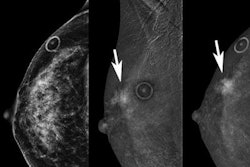
Non-Hispanic Black women are more likely to receive a false-negative breast cancer report and non-Hispanic white women have higher invasive cancer detection rates, wrote the authors of a study published June 17 in Cancer Epidemiology, Biomarkers & Prevention.
 Sarah Nyante, PhD.
Sarah Nyante, PhD.Researchers led by Sarah Nyante, PhD, from the University of North Carolina also found other variations in racial and ethnic groups when it comes to the accuracy of diagnostic mammography, including later diagnoses for Black women and higher proportions of ductal carcinoma in situ (DCIS) in Asian and Pacific Islander women.
"Our findings indicate that factors associated with the imaging facility, rather than individual characteristics, may explain some of these differences, particularly since the study population consisted of women who had already received a screening mammogram," Nyante and colleagues wrote.
Differences in breast cancer screening and diagnosis, as well as tumor characteristics have been studied over the years. Research suggests that in the U.S., breast cancer incidence is highest among non-Hispanic white and non-Hispanic Black women. Meanwhile, breast cancer-related mortality is highest for non-Hispanic Black women.
Mammography's role in breast cancer detection is important, but its contributions to racial differences aren't understood. While previous research has attempted to address racial and ethnic differences in timeliness of screening and care, the study authors wrote that little is known about differences in other parts of diagnostic workup, such as outcomes.
Nyante et al wanted to assess differences in racial and ethnic groups when it comes to diagnostic digital mammography's performance following a recent screening mammogram. They looked at prospective performance statistics among non-Hispanic white, non-Hispanic Black, Asian and Pacific Islander, and Hispanic women.
"Examining differences in diagnostic digital mammography performance and tumor characteristic outcomes by race and ethnicity may help to understand why disparities in cancer detection and quality of care may persist for some demographic groups," they added.
The researchers gathered data from 267,868 diagnostic mammograms performed to evaluate screening mammogram findings at 98 facilities in the Breast Cancer Surveillance Consortium (BCSC) between 2005 and 2017.
| Breast cancer diagnosis characteristics among racial and ethnic groups | ||||
| Hispanic | Asian/Pacific Islander | Non-Hispanic white | Non-Hispanic Black | |
| Invasive cancer detection rate (per 1,000) | 22.3 | 31.6 | 35.8 | 29.5 |
| Positive predictive value (per 1,000) | 19.4 | 24.3 | 27.8 | 23.4 |
| False-positive reports (per 1,000) | 136.1 | 169.2 | 126.5 | 133.7 |
| False-negative reports (per 1,000) | 2.6 | 3.3 | 4.0 | 4.6 |
The researchers also found that non-Hispanic Black women were the most likely to receive short-interval follow-up recommendations, with 31% of women recommended for further imaging within six months. Meanwhile, such recommendations were made for 22.1% of white women, 16.1% of Asian/Pacific Islander women, and 23.6% of Hispanic women.
Asian and Pacific Islander women had the largest proportion of DCIS at 43%, and Black women were more likely to be diagnosed with later-stage tumors and higher tumor grade. They were also more likely to be diagnosed with the aggressive triple-negative breast cancer subtype.
However, Nyante said that controlling for patient-level characteristics did not explain the differences in performance statistics in this study. She said this suggests that the role of the diagnostic facility in women's breast cancer treatment should be further studied.
Nyante told AuntMinnie.com that the team is working on a second study evaluating diagnostic mammography performance among women with breast symptoms.
"Women with symptoms are typically diagnosed with worse-prognosis breast cancers than screening participants, so it will be interesting to see if the same types of racial and ethnic differences in diagnostic mammography performance are present in the symptomatic population and to what extent that is reflected in the tumor characteristics of the population," she said.




















